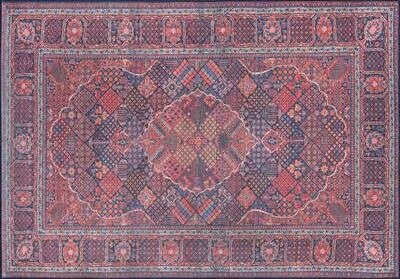Afshar Rug Persian Rug, The history of the Afshar rug is as long as the last one-third of Iran’s. Their back-to-back immigration to the Iran Plateau began roughly one thousand years ago. Several branches of the Afshar people scattered in Iran and Anatolia under the Seljuks’ rule. Mongol invasion accelerated the still continuing immigration; thus, by the Timurid Empire’s fall, they were a potent tribal power, settled in almost corner of Iran.



History of Afshars
The Afshars played a vital role in the rise of the next empire, the Safavids, as one of the seven tribes of Qizilbash: the crimson-capped guardians of the empire. Shah Tahmasp of the Safavid dynasty moved many Afshar people from Azerbaijan to the plains to the south by force.
Nader Shah the great, an Afshar commander, ended the chaos after the fall of the Safavid dynasty. He sat on the throne in 1736 as Shah of Persia, founding the Afsharid dynasty. By clutching firmly to their nomadic lifestyle, Afshar rug maintained many cultural aspects. Rug weaving was one of those aspects that remained predominant and kept the folks’ iconography alive. The rug market frequently uses the term Afshar in Persian rug discourse.

You would hear the word describing an influencing style in Azerbaijan rug or high-grade rugs amongst Bijar rugs. Nevertheless, the term Afshar is mainly referring to the tribal rugs in local bazaars of Kerman and Fars, Sirjan, Rafsanjan, and Shahr-e Babak. Afshar Rug Persian Rug.
Technical Aspects and Structure of Afshar Rug
Offset warp and pink (or orange) weft are the key clues to Afshar piled rugs. In the past, most Afshar rugs were completely woolen, but during the 20th century, cotton became typical for warp and weft. Knots are symmetrical (Turkish) and double-wefted.
One could also find asymmetrical (Persian) knotted rugs among new woven goods, especially in Shahr-e Babak, where rug weavers are more under the influence of Kerman rugs.
Area rugs are more popular than carpet sizes or runners between Afshar rugs. Sirjan rugs are typically coarser in weave than goods woven in Shahr-e Babak. Sirjan weavers tend to rather squarish shapes while other areas follow more standard sizes.



Dyeing and Painting of Afshar Rug
Glowing red and midnight blue are predominant colors in Afshar rugs, though the rug weavers don’t limit themselves in using other colors as subsidiaries. Shahr-e Babak rugs enjoy a unique rosy-brown hue you can’t fail to recognize.
Indigo, cochineal, walnut, weld, pomegranate, vine and cherry leaves, straw, henna, saffron, turmeric, poppy, and madder are the primary natural dying materials.
Designs and Patterns of The Afshar Rug
The range of Afshar rug designs is too wide to be mentioned in a single article. They inherit several traditions. That includes their Turkic origins, what they share with Caucasian people, and what they gained from town weaving styles of Kerman during the 20th century with the boom in the Kerman rug industry. Of course, these traditions work in fusion, and their effect varies in different areas of the province.
Patterns are primarily rectilinear due to the nature of the tribal weaves. Still, you could find curvilinear patterns mainly in semi-nomadic rural areas influenced by city workshops and old shawl weavings of Kerman (a variety of Botehs are the most important ones that mainly serve as repeating patterns).
Different types of Boteh could be enumerated in both rectilinear and curvilinear shapes: Paisley Bush, Mother, and Infant.
Rectilinear lozenges are very common which form different shapes. There is a so-called Three-Medallion design formed of three small diamond-shaped medallions in a bigger medallion which is a certain clue to Sirjan rugs. Central geometric medallion with jagged cornering is another typical design of Sirjan. (Sirjan is also known in western markets as Sirjand. Different Romanized versions of Persian names are not unusual, but we have no idea from where this “d” has come.
The tree of life is another basic design that Afshar rug shares with other nomadic rugs, sometimes intermingled with vase designs. Afshar weavers tend to fill empty spaces between branches with decorative patterns such as animals, human motifs, stars, and rosettes. This affection for embellishing patterns is also valid in other basic Afshar rug designs.

If this glamorous rug has successfully grabbed your attention, then we invite you to explore the fascinating collection of Afshar rugs in our Louisville, KY Rug Store. Visit us today and we’ll gladly help you find the right rug that perfectly matches your style and budget.

